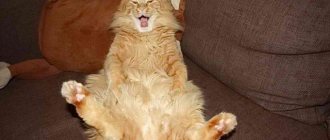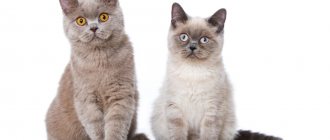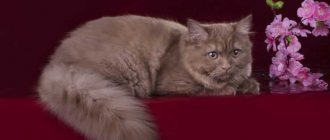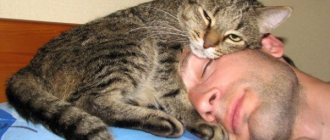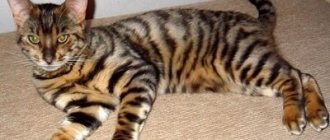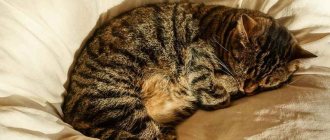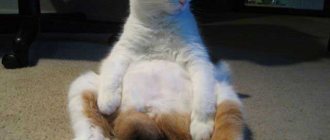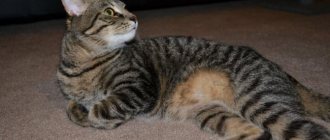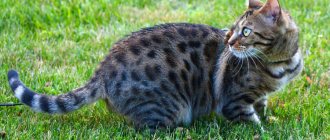A cat with squint is not uncommon, especially among certain breeds. Many owners even like this feature, but how much does this pathology affect the well-being and quality of life of the animal? The disease has several stages of development; in the initial stages it is quite difficult to identify deviations. However, if you suspect that your cat is cross-eyed, you should take her to the vet. If the pathology is congenital, then it will not affect the quality of life of the animal, but if strabismus has developed as a result of injuries or other diseases, the situation should not be left to chance under any circumstances.
Signs and types of strabismus
Strabismus in cats can be unilateral, when only one eyeball deviates from its normal position, or bilateral, when the disorder extends to both eyes. The eyeballs are mobile, and their joint movement in the orbits is ensured by several small muscles. If, for some reason, the coordinated work of these muscles is disrupted, or the eyeball is displaced relative to its correct position within the orbit, then strabismus occurs.
In many cases the problem can be determined visually , but this is not always possible. If the cat's eyes are oriented differently, the pupils and corneas are asymmetrically located, these obvious signs will indicate strabismus. If the asymmetry is not too obvious or not noticeable at all, you can observe the cat. If, while looking at an object, her two eyes fixate on it differently, she probably has strabismus.
If the cat's pupils are close to the nose, which is often found in cats of Siamese or Oriental breeds, then this type of strabismus is called convergent. If, on the contrary, the pupils are deviated from the nose in different directions, then the observed strabismus is called divergent. Convergent strabismus is more common and is often congenital. Strabismus that occurs in an initially healthy cat is acquired and can be caused by many different factors.
This is interesting: A cat’s eye is leaking, what to do?
Character and temperament
Caracat is a hybrid cat with a pleasant, but rather contradictory disposition. From his wild ancestor he inherited the desire for independence and independence. Therefore, you should not expect that the caracat will turn into a pet.
Representatives of the hybrid breed inherited an affectionate, obedient and non-aggressive character from domestic cats. Curious and energetic caraquets never give up on outdoor games and enthusiastically take part in all household chores. Representatives of the breed need constant communication with people and easily tolerate changes in environment. Caracats love nature walks and road trips.
Patient and non-aggressive caraquets do not pose a danger to the owner's children. But if the child is too pushy, the hybrid cat may hiss or release its claws.
The caraquet gets along well with other pets, with the exception of decorative rodents and birds. A strong hunting instinct prevents a hybrid breed cat from making friends with hamsters or parrots.
Are all Siamese and Thai cats cross-eyed?
Siamese and Thai breeds are prone to this unusual symptom due to the presence of the acromelanism gene in the body. Thanks to him, the animal has an unusually beautiful outfit called color point. It is characterized by the presence of dark-colored limbs and a cream-colored body; the eyes have a rich sky blue color.
Smiling cross-eyed Siamese cat
However, not everything is so wonderful. This gene is also associated with improper development of the optic nerve, which causes the pet to see double images. Advanced forms of pathology can be aggravated by the development of nystagmus - frequent oscillatory movements of the pupil that occur in order to piece together a split picture.
Of course, not all representatives of these breeds suffer from strabismus. The presence of acromellanic coloration is undoubtedly considered a risk factor. A similar pathology can also be detected in Straights, Scottish Folds, Sphynxes and other breeds. The disease can also develop when breeds are crossed incorrectly.
Note! Albino cats are prone to developing strabismus and nystagmus.
Breed characteristics
Standard
- Appearance: The Tonkinese cat should give the impression of a compact, proportionally built animal, neither strong nor thin in build. The animal should not be light in weight, despite its small size. This is a muscular cat, active and emotional.
- Torso: should not give the impression of being squat or excessively slender; proportionality is preferable to size. The muscles are well developed, but not excessively.
- Legs and paws: quite graceful, proportional to the body. The hind legs are slightly longer. The paws are small and oval.
- Tail: medium length, proportional to the rest of the body, pointed at the end.
- Head: wedge-shaped, but rounded, with high, non-sharp cheekbones, clean contours. The edges of the chin and nose are on the same vertical line. The transition between the forehead and nose is not sharp, the forehead is slightly convex.
- Ears: Proportional to the body, medium in size and rounded at the tips. Set so wide and high.
- Eyes: proportional to the rest of the muzzle, almond-shaped, open. Deep and pure shades are desirable, from aquamarine to sea green.
- Coat: short, close-lying, shiny, silky to the touch, without undercoat.
Colors
The “calling card” of the breed is the mink color, when the dark color of the points smoothly transitions to a lighter color of the body. In adult animals, the mask and ears are connected by tracing (dark paths). With age, the animal darkens, the color “blurs out”. The following variations are allowed:
- natural mink;
- champagne mink;
- blue mink;
- platinum mink.
Photos of colors
Solid colors (Burmese) with eye color from green to yellow-green, pointed (Siamese) with blue eye color are also allowed. The color variations are the same.
Animals are disqualified from:
- yellow eyes;
- squint;
- white medallions;
- crooked tail.
Health
The weight of representatives of the breed ranges from 2.5 to 5.5 kg, males are larger than females. In general, Tonkinese cats have good health. With proper care, they can live 15 years or more.
However, “bad heredity” sometimes makes itself felt. There may be problems with teeth (as with Siamese), and liver amyloidosis - representatives of all breeds of the Siamese-Oriental group are prone to it. The instability of Tonkinesis to upper respiratory tract infections is also noted.
Personality of the Tonkinese cat
The Tonkinese, due to its relationship with the Siamese, has a lively and friendly character. Such a pet strives to communicate with all family members, including other animals. These cats adore their owners and love to tell them all their cat news, except that their voices are softer and quieter.
Representatives of the Tonkinese breed feel good in any, even noisy, family and get along with children - provided that adults have explained to them how to behave with an animal. It is believed that communication with tonkinesis has a positive effect on the condition of a child suffering from certain mental disorders.
Causes of strabismus
Congenital strabismus - in this case, a cat may have strabismus from birth due to a genetic predisposition. In this case, strabismus is usually bilateral. The tendency to squint can be inherited. Individuals with congenital strabismus are not recommended for breeding so that the defect is not passed on to descendants.
Strabismus is especially common in cats of Oriental and Siamese breeds, which have a predisposition to such a violation of the location of the eyeballs. Typically, in Siamese and Orientals one can observe convergent strabismus, which is associated with the peculiarities of the internal structure of the visual organs. Minor strabismus that occurs initially in an animal and is not caused by external causes usually does not require treatment, since it has virtually no effect on the cat’s quality of life.
Trauma . The eyeball may deviate from its normal position as a result of eye injury, for example, from a fall from a height or a strong blow. As a result of injury, the eye muscles can receive mechanical damage, or the optic nerve is damaged, which can result in either unilateral or bilateral strabismus.
The cause of strabismus may be a disease that affects the muscles responsible for positioning the eyeball, such as fibrosis. The shift may also be due to a neoplasm inside the orbit or an inflammatory process.
Violation of the vestibular apparatus . If the cat's vestibular system is malfunctioning, the eyeballs may also deviate from the correct position. The vestibular apparatus is responsible for positioning the cat's body in space, and if it functions incorrectly, the brain incorrectly perceives information about the position of the animal's head, which can cause the development of strabismus.
Does inherited strabismus require correction?
The good news is that in the case of strabismus, which is due to a genetic predisposition and does not develop as a result of some disease, the defect is considered cosmetic and does not cause any particular inconvenience to the animal. Moreover, some cat lovers note that cross-eyed cats look very cute, touching and funny, and this defect only gives them individuality.
An example of this is the charming ginger cat Jarvis (Jarvis P. Weasley) from California, adopted from a shelter despite an obvious eye defect, and beloved by his owners and subscribers.
An Internet star named Spangles also squints in one eye. This charming cat from South Carolina has many fans around the world. Spangles' owner, Mary, claims that strabismus does not prevent the cat from living “to the fullest” and posing in extravagant outfits.
Strabismus in kittens
In veterinary practice, the incorrect location of the eyeball in a cat in the orbit of one or both eyes, when the visual axes do not intersect at one point, is called strabismus. Converging pupils at the nose are called esotropia, and diverging pupils in different directions are called exotropia.
In kittens, this phenomenon occurs most often, because... due to weak eye muscles, the pupil may look in one direction or the other, but there is nothing wrong with that. Typically, early strabismus in an animal goes away after 5-6 months.
But sometimes it happens that the cat’s strabismus remains with it even after a long time. In this case, you need to visit a veterinarian to determine the cause.
If the matter is a genetic predisposition, then there is nothing to be afraid of, the cat will be able to live with this feature. And if your pet develops strabismus as an adult, this is a cause for concern.
Acquired strabismus can be a consequence of diseases such as:
- viral infections;
- diseases of the nervous system;
- benign and malignant tumors;
- disorders in the vestibular apparatus;
- consequences of injuries.
The veterinarian must determine the cause of strabismus and, if it was acquired as a result of illness or injury, begin treatment in a timely manner. In such cases, strabismus is only a consequence of a disease that can lead to serious problems with the pet’s health.
Most often, strabismus is inherited by a cat from its ancestors.
Maintenance and care
It is easy to care for the coat of such animals; it is enough to thoroughly comb it weekly with a special brush.
It is not recommended to bathe the blue-eye often - 1-2 times a month will be enough. Bathing is carried out using cat shampoo and conditioner, and then wipe the pet dry with a warm terry towel and do not let it out into drafts. Eyes and ears should be washed as they become dirty with cotton pads soaked in warm water, or the ears should be treated with a soft cloth. The use of cotton swabs to clean ears is strictly prohibited, so as not to harm the animal. Pay special attention to the animal’s mood, as it is characterized by a touchy character. Because of this feature, a cat may fall into a prolonged depression and refuse to walk, eat or drink.
The right way to get rid of an animal’s depressed state is to give it maximum attention, provide it with care, affection and love. In your free time, you should try to keep your cat busy with active games as much as possible.
Provoking factors of development
Feline strabismus is medically called strabismus. Pathology can be either congenital or acquired. In the latter case, the defect develops against the background of injuries - severe blows to the head or due to falls. Also, a kitten can become cross-eyed after certain diseases:
- developmental pathologies or disturbances in the functioning of the vestibular apparatus (disorientation);
- encephalitis is a viral pathology accompanied by inflammation of brain tissue;
- dysfunction of the central nervous system organs;
- hydrocephalus or dropsy - a disease accompanied by the accumulation of cerebrospinal fluid in the head;
- rabies;
- meningitis - inflammation in the mucous membranes of the brain or spinal cord;
- otitis of the middle or inner ear;
- glaucoma – sudden changes in pressure inside the eye;
- The feline leukemia virus is a disease whose symptoms are very similar to cancer.
A dog whose eyes fall out: a review of breeds
Strabismus sometimes appears due to a hereditary predisposition. If the genetic eye disease is mild, then there is no need for treatment. Oblique cats quickly adapt and are able to lead a full life.
Important! A purebred cross-eyed cat should not be allowed to be bred in the future.
After injury, due to physical impact, the eyeball deviates from its usual, correct position. Diseases that affect muscle tissue can also provoke strabismus. The cause of the shift may be the development of a neoplasm inside the orbit or the occurrence of inflammatory processes.
Problems in the functioning of the vestibular apparatus lead to the fact that the eyeballs can change their location. The fact is that thanks to the vestibular system, a cat can navigate in space. If something doesn’t work correctly, the brain is not able to correctly perceive information about the position of the head, which, in fact, becomes the cause of strabismus.
Clinical picture of rabies in cats
The development of strabismus can also be provoked by a disturbance in the interaction of the organs of the nervous system (CNS) with the organs of vision.
Note! The occurrence of malignant processes in the brain quite often provokes the development of strabismus.
This is interesting: Why do cats' eyes glow in the dark?
The most common causes of pathology
Firstly, as we have already said, strabismus can be congenital (the reasons for this phenomenon have not been studied). This phenomenon is especially typical for “Scots”, Persians, Siamese cats, as well as crossbred animals. It does not have any negative effects, except for mild myopia in cats. Note that congenital strabismus is very often accompanied by congenital nystagmus.
This is especially true for Siamese and Sphynx cats. Both of these pathologies are practically the norm for cats of the named breeds; no treatment is required (and it will not help). Other causes of strabismus in cats:
- Hydrocephalus, that is, dropsy of the brain. It happens that this is associated with strabismus in kittens.
- Infection with feline leukemia virus.
- Inflammation of the middle and/or inner ear, as well as meningitis or encephalitis.
- Injury or inflammation of the muscles of the eyeball itself. This happens extremely rarely in cats, but occurs in Britons.
- Cancer of the brain or optic nerve.
Eye diseases in cats
Eye diseases in cats are a large group of diseases. Some of them are inflammatory (infectious), some are non-inflammatory (non-infectious).
Conjunctivitis
The most common inflammatory eye disease in cats.
Causes
May occur due to injuries, allergic reactions, foreign bodies, chemicals, infectious diseases, vitamin deficiencies, etc.
Symptoms
Conjunctivitis is indicated by:
- milky pale film;
- the animal constantly rubs its eye;
- discharge from the eyes.
Treatment
Catarrhal conjunctivitis is treated with aqueous solutions of drops of 0.25% chloramphenicol, 10% sodium sulfacyl instilled into the conjunctival cavity, 2-3 drops 3-4 times a day.
For purulent conjunctivitis in a cat, wash the eyes with a solution of furatsilin (1:5000), solutions of antibiotics, sulfonamides. Use tetracycline, erythromycin and other ointments (place 2-3 times a day in the conjunctival cavity). Intramuscular administration of antibiotics is possible.
Conjunctivitis is a contagious disease. It is necessary to isolate the cat from other pets, and after contact with a sick animal, wash your hands thoroughly.
Injuries
The most common eye pathology is non-infectious. It is especially common in cats that go outside. If a family has several pets, then fights between them are possible.
Causes
- scratches (claws, hard objects);
- falling from a height;
- attack by aggressive relatives and dogs;
- foreign body entering the eye;
- punctures;
- bruises;
- bites;
- lacerations.
Symptoms
- redness of the eyes;
- tearfulness;
- pain syndrome;
- swelling;
- discharge from the eyes.
Treatment
Treatment comes down to antibiotic therapy, anti-inflammatory and painkillers (ointments, eye drops). In difficult cases, surgery may be required.
Entropion and eversion of eyelids
Causes
Turning inward or turning outward of the edges of the eyelids occurs due to injuries, inflammatory processes, burns, and with a reflex spasm in acute conjunctivitis.
Symptoms
- the eyelashes and the edge of the eyelid are turned inward;
- wet eyes;
- severe lacrimation;
- redness of the conjunctiva.
Vaccinations and antiparasitic treatment
To protect the Tonkinese cat from viral and infectious diseases, it is systematically vaccinated against rabies, panleukopenia, rhinotracheitis and calcivirosis. The first vaccination is given to a kitten at 7-8 weeks and repeated after 28 days. Subsequently, the Tonkinese is vaccinated once a year.
To prevent diseases transmitted by parasites, the cat is regularly treated for worms and fleas. Representatives of the Tonkinese breed are given anthelmintic medications once every six months, repeated every 10-14 days. Protect against Tonkinese fleas with special collars, drops and shampoos.
Clinical picture and types of strabismus
The acquired disease in animals can develop unilaterally or bilaterally. In the first option, only one eye changes its anatomically correct position, in the second case, respectively, two. Both eyes move in their orbits; several small muscles are responsible for this function. Strabismus occurs when the functioning of these muscle tissues is disrupted and the eyeball is displaced.
1st Choice for cats: Fest Choice food review
In the vast majority of cases, deviations can be detected visually. A clear sign of strabismus is evidenced by asymmetrically located corneas and pupils.
Note! If an animal fixes its gaze on a certain object, but its eyes are fixed differently, then this indicates the presence of pathology.
Representatives of Siamese and Oriental breeds often have pupils close to the nose. This form of pathology is called convergent. If, on the contrary, the pupils are distant from the nose, then this form of the disease is called divergent. The first form is the most common and is often congenital.
Unilateral strabismus in cats
Types of heterotropia in pets
First of all, heterotropia in a pet can be:
- congenital;
- acquired.
The type of illness affects the nature of therapy
If the ocular axes are directed towards the nose, then this type of strabismus will be convergent.
The photo below shows just the converging type of strabismus.
Convergent form of violation
If the eye axes are directed in different directions, then this view is considered divergent.
READ Domestic donkey origin description
If an animal has only one gas, then it is unilateral strabismus. If both eyes are squinting, it is bilateral.
Causes of strabismus in cats
Strabismus in cats and other pets develops due to damage to the smooth transverse muscle that holds the eyeball in the orbit. Strobism can also occur as a result of thinning of the fat layer, anomalies in the structure of the orbit, or serious pathologies of the deep structures of the eye.
In most cases, cats are diagnosed with congenital rather than acquired strabismus. In this case, ophthalmological pathology can develop in either one or both eyes of a pet. Strabismus can be accompanied by a turn of the eyeball in any direction, but the shape of the pupil is not changed. Strabismus is diagnosed in cats of various breeds, regardless of age.
Causes of strabismus in cats:
- closed, open craniocerebral injuries, which can provoke displacement of the eyeball;
- brain contusions, brain hypoxia;
- genetic, breed predisposition;
- dysfunction of the vestibular apparatus;
- disruptions in the functioning of the nervous and endocrine systems;
- inflammatory processes in the muscle structures of the eyeball;
- vascular pathologies;
- cancer of the brain, optic nerve;
- neoplasms in the orbit, eyeball;
- infections, chronic diseases of various etiologies.
Injuries and severe bruises can cause disruption of innervation, damage to the optic nerves, and the structure of the path of the visual impulse to the brain. Autoimmune infections, chronic bacterial, viral, parasitic infections, for example, viral leukemia, rabies, Aujeszky's disease, listeriosis, toxoplasmosis, blastomycosis can also cause acquired strobism in cats.
Strabismus can be a consequence of congenital or acquired chronic nervous pathologies. A similar pathology is observed with bacterial meningitis and granulomatous meningoencephalomyelitis.
As for breed predisposition, I often diagnose strabismus in Persians and their crossbreeds, Siamese cats, Orientals, and Scottish Folds. In addition, Siamese have naturally poorer binocular vision compared to other breeds.
Reasons why eyes come in different colors
Different eye colors are called heterochromia. The phenomenon is found in cats, other animals, even humans. The cause of heterochromia has not been fully established.
The most likely factors are the following:
- lack or excess of melanin - the pigment is responsible for the color of the iris and affects the color depending on the concentration and uniformity of distribution;
- white wool gene W - if it is transferred to the retina of the eye, then the color of the iris of one or two eyes becomes blue;
- pathologies - often multi-colored eyes are found in cats, which have a strong predisposition to leukemia and the formation of cancerous tumors.
Cat Breeds Prone to Strabismus
Cats of any breed can have strabismus, but there are animals among which it is most common:
- Siamese;
- Thai;
- snow-shoe;
- Balinese;
- Javanese.
Cross-eyed Siamese cat
This phenomenon is associated with a special gene called “acromelanism”. It is he who gives cats an unusual color of fur and eyes (dark paws and tail, light body and bright blue eyes). But this gene gives cats not only beauty, because of it the optic nerve develops incorrectly, the cat sees everything in double form, and objects look flat. Attempts to put it all together and take a better look lead to the pet acquiring slanted eyes, sometimes the pupils move from side to side.
Mister Cat talks: famous cross-eyed cats
Due to the fact that cats with strabismus look touching and special, their owners do not miss the opportunity to show everyone around their special pet.
For example, the popular cat Spangles from South Carolina. His squint does not in the least prevent him from living life to the fullest, having fun and posing for the camera in various outfits.
Spangles
Spangles
Spangles
Spangles
Spangles
And here is a ginger cat from California named Jarvis. He was found by his current owners on the street at 4 weeks of age. Apparently, the previous owner, having noticed a flaw in the kitten in the form of slanted eyes, decided to get rid of it in this way. The cat was picked up by a local resident and at first wanted to give him to a shelter, but then she changed her mind and kept the baby with her.
Jarvis
Jarvis
Cat Jarvis gained fame and was loved by millions of people when his owner posted his photos on the Internet. People couldn't ignore such a charming and funny ginger cat. And Jarvis’s owner herself says that the cat has been incredibly smart, active and cheerful since childhood, and she is very glad that she did not give him to a shelter.
Jarvis
Jarvis
Is correction required?
Hereditary strabismus is only an external feature that does not cause any inconvenience to the cat and does not harm it.
It’s another matter if strabismus was acquired in adulthood, then immediate help from a specialist is needed. To accurately diagnose problems with the nervous system and vestibular system, an MRI of the eye orbits or brain may be required.
For various inflammatory diseases, drug treatment is necessary, which is prescribed by a veterinarian. With proper and timely therapy, strabismus in your cat will be completely cured.
If the problem of strabismus is associated with various injuries or damage to the eye muscles, then there is only one way out of the situation - surgical intervention. The operation will have a good outcome only if the disease is detected at an early stage. Otherwise, the animal will face unpleasant consequences for its health and well-being.
That is why it is so important to promptly contact a veterinary clinic as soon as the disease is identified.
How does it affect your pet's health?
Quite often, cats pay for different colors of the iris with hearing impairment, even complete hearing loss. With an equal degree of probability, an animal may be deaf in one ear or both.
One-sided deafness or significant hearing loss in one ear and complete loss in the other are also possible. The phenomenon occurs if the cause of different-colored eyes is a genetic factor, which often disrupts the development of the hearing aid. But this is not a rule, and the animal may turn out to be full-fledged.
Deafness is not found in all cats with unusual appearance.
Because of this, before selling kittens, a conscientious breeder usually obtains a veterinary report on the condition of the animal. A kitten with partial or complete deafness costs less than a fully hearing one.

